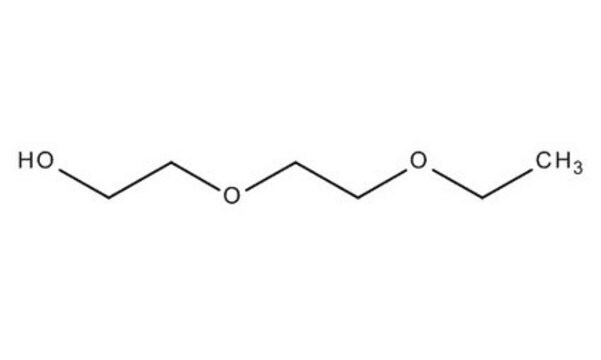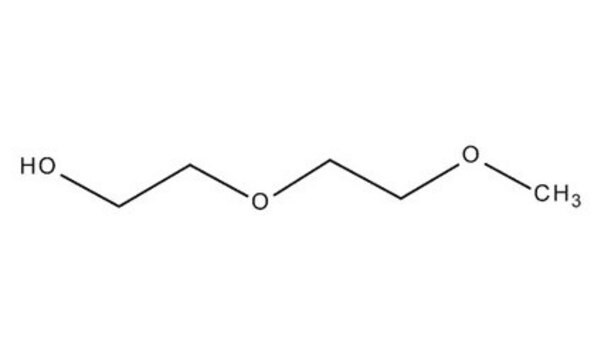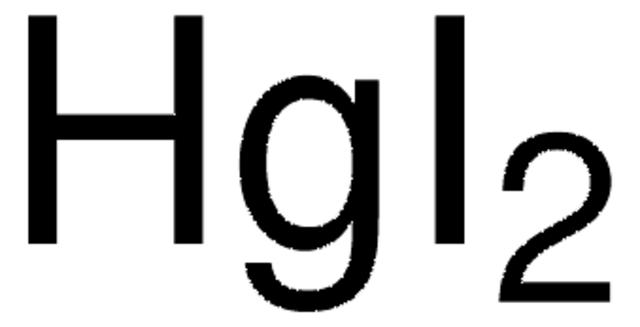8.03129
Diethylene glycol monobutyl ether
for synthesis
Synonim(y):
Diethylene glycol monobutyl ether, Butyl carbitol, 2-(2-Butoxyethoxy)ethanol, Butyl diglycol
About This Item
Polecane produkty
ciśnienie pary
<1 hPa ( 20 °C)
Poziom jakości
Próba
≥98% (GC)
Formularz
liquid
temp. samozapłonu
210 °C
siła działania
5660 mg/kg LD50, oral (Rat)
4120 mg/kg LD50, skin (Rabbit)
granice wybuchowości
0.7-5.9 % (v/v)
pH
7 (20 °C)
Lepkość kinematyczna
6.1 cSt(20 °C)
bp
226-234 °C/1013 hPa
mp
-68 °C
temp. przejścia
flash point 105 °C
gęstość
0.95 g/cm3 at 20 °C
temp. przechowywania
2-30°C
InChI
1S/C8H18O3/c1-2-3-5-10-7-8-11-6-4-9/h9H,2-8H2,1H3
Klucz InChI
OAYXUHPQHDHDDZ-UHFFFAOYSA-N
Powiązane kategorie
Zastosowanie
- Biopolymeric Anticorrosion Coatings from Cellulose Nanofibrils and Colloidal Lignin Particles.: This study describes the development of a novel anticorrosion coating made from biopolymers, including a discussion on the use of diethylene glycol monobutyl ether as a solvent to disperse components uniformly (Dastpak et al., 2021).
- The investigation of structural and thermosensitive properties of new phosphazene derivatives bearing glycol and amino acid.: This research article explores the properties of phosphazene derivatives that incorporate glycol structures, detailing methods like NMR and IR spectroscopy where diethylene glycol monobutyl ether may be employed as a solvent in the synthesis process (Uslu and Güvenaltın, 2010).
- Diethylene glycol mono butyl ether concentrations in room air from application of cleaner formulations to hard surfaces.: This study measures the air concentrations of diethylene glycol monobutyl ether in indoor environments following its application in cleaning agents, demonstrating its volatility and potential inhalation exposure during use (Gibson et al., 1991).
Komentarz do analizy
Density (d 20 °C/ 4 °C): 0.951 - 0.954
Water (K. F.): ≤ 0.20 %
Peroxide (as H₂O₂): ≤ 0.05 %
Identity (IR): passes test
Hasło ostrzegawcze
Warning
Zwroty wskazujące rodzaj zagrożenia
Zwroty wskazujące środki ostrożności
Klasyfikacja zagrożeń
Eye Irrit. 2
Kod klasy składowania
10 - Combustible liquids
Klasa zagrożenia wodnego (WGK)
WGK 1
Temperatura zapłonu (°F)
210.2 °F - closed cup
Temperatura zapłonu (°C)
99 °C - closed cup
Certyfikaty analizy (CoA)
Poszukaj Certyfikaty analizy (CoA), wpisując numer partii/serii produktów. Numery serii i partii można znaleźć na etykiecie produktu po słowach „seria” lub „partia”.
Masz już ten produkt?
Dokumenty związane z niedawno zakupionymi produktami zostały zamieszczone w Bibliotece dokumentów.
Klienci oglądali również te produkty
Nasz zespół naukowców ma doświadczenie we wszystkich obszarach badań, w tym w naukach przyrodniczych, materiałoznawstwie, syntezie chemicznej, chromatografii, analityce i wielu innych dziedzinach.
Skontaktuj się z zespołem ds. pomocy technicznej













